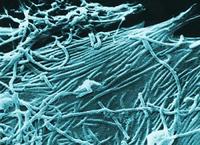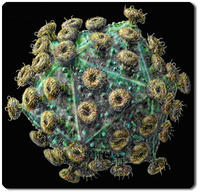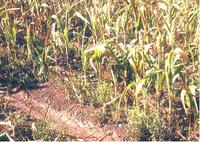-
New wireless sensor quickly detects E. coli in water samples
Fecal contamination of public beaches caused by sewage overflow is both dangerous for swimmers and costly for state and local economies; current methods to detect E.coli, a bacterium highly indicative of the presence of fecal matter in water, typically require 24-48 hours to produce a result; new detection method cuts this time to 1-8 hours
-
-
MSU lands USDA grants totaling nearly $3 million to improve food safety
Three Michigan State University researchers landed grants totaling nearly $3 million from the U.S. Department of Agriculture (USDA) to improve food safety; the three professors are part of the recently created MSU Food Safety Group; this team comprises about thirty MSU researchers from more than ten departments working with other universities around the world to improve food safety
-
-
Progress made toward a vaccine for Ebola

Ebola is one of the most lethal, naturally occurring pathogens on earth, killing up to 90 percent of its victims, and producing a terrifying constellation of symptoms known as hemorrhagic fever; scientists have now made significant progress toward a vaccine against the deadly virus – and this Ebola vaccine could be stockpiled for use in the United States, should the country fall victim to a natural outbreak or a bioterrorism event in which a weaponized strain of the virus were unleashed on soldiers or the public
-
-
How the bioweapon ricin kills
Ricin is one of the deadliest plant based poisons in the world, and what makes it especially dangerous is that it comes from the humble castor oil bean and is available in many health food shops or online; scientists discover the protein that controls how ricin kills
-
-
Safe farm practices initiative launched
Ever since 2006, when a deadly batch of spinach killed three people and sickened hundreds, U.S. farm producers, packers, and others along the distribution line have argued over how best to protect consumers and assure them that leafy greens and tomatoes are safe; now, a major initiative aims to settle these arguments
-
-
Detecting botulinum toxin
A company specializing in molecular diagnostic tests based on Single Molecule Array (SiMoA) technology has been awarded a contract from DHS to develop an assay capable of detecting single molecules of botulinum toxin (BoNT) within complex environmental samples
-
-
U.S. unprepared for biological attack
The United States is inadequately prepared to respond to a biological attack and there are several severe weaknesses in its defense capabilities. According to a New York Times investigative report, funding issues, competing agencies with different priorities, and an overall lack of urgency have contributed to a situation where the U.S. lacks countermeasures to combat a number of biological agents that could be used in an attack
-
-
Natural killer cells help human body fight off infections

Researchers have discovered a new type of cell which boosts the human body’s ability to fight off infections and life-threatening diseases; the researchers found a type of cell which recognizes lipid antigens, or foreign molecules, which sit on infectious bacteria which invade the body
-
-
Five years after E.coli outbreak, California farmers still struggling
Farmers in Salinas Valley, California, the “salad bowl of the United States,” are still struggling to regain consumers’ trust five years after spinach grown and bagged on a local farm was linked to a deadly E. coli outbreak that killed three people and sickened 206
-
-
"Left-handed iron corkscrews" a new weapon against superbugs

Scientists have taken inspiration from corkscrew structures found in nature to develop a new weapon in the fight against infections like E-coli and MRSA; researchers have created a new synthetic class of helix-shaped molecules which could be a key tool in the worldwide battle against antibiotic resistance
-
-
New compound breaks down HIV's outer envelope

One of the reasons HIV is so difficult to treat is that it continually evolves the proteins on its membrane to increase its resistance to immune systems; researchers at Texas A&M University and the Scripps Research Institute have now discovered a compound which breaks down the outer envelope of HIV
-
-
Study promises possible therapy for radiation sickness
Studies of potential radiation therapies suggest they would be effective in humans only if administered within a few minutes or hours of radiation exposure, thus making them impractical for use in response to events involving mass casualties; the larger time window for administering a new 2-drug regimen ofeers the prospect that it could become a mainstay of the response to public health threats such as a nuclear power plant accident or nuclear terror attack
-
-
CDC concludes NBA outbreak investigation
A recently concluded investigation by the Centers for Disease Control and Prevention (CDC) reveals that norovirus was the cause of an outbreak that sidelined more than twenty-four NBA players and staff members from thirteen teams in 2010
-
-
Listeriosis outbreak causes 29 deaths, costs producer $150 million
Four outbreak strains of L. monocytogenes, the bacterium that causes listeriosis, were found in twenty-six states, leading to twenty-nine deaths and thirty-three additional illnesses; settlements to the families may cost $150 million; an investigation by the FDA and CDC identify a Colorado cantaloupe producer as the source of the outbreak
-
-
Alien species: a dangerous new bioterrorism threat

Federal counterterrorism officials have a potentially catastrophic new threat to worry about – invasive alien species; the threat is so serious, Lawrence Roberge, an associate professor of anatomy and physiology at Laboure College, warned that terrorists could seek to use invasive species as biological weapons
-
More headlines
The long view
We Ran the C.D.C.: Kennedy Is Endangering Every American’s Health
Nine former leaders of the Centers for Disease Control and Prevention (CDC), who served as directors or acting directors under Republican and Democratic administrations, serving under presidents from Jimmy Carter to Donald Trrump, argue that HHS Secretary Roert F. Kennedy Jr. poses a clear and present danger to the health of Americans. He has placed anti-vaxxers and conspiracy theorists at top HHS positions, and he appears to be guided by a hostility to science and a belief in bizarre, unscientific approaches to public health.
